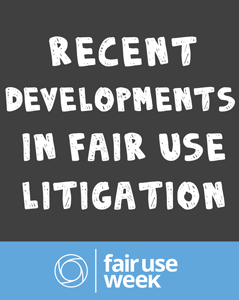Recent Developments in Fair Use Litigation
Recent Developments in Fair Use Litigation
The shaping of fair use has always been done by the courts. Even the fair use statute is derived from long standing case law. The most significant recent fair use decisions involve Google Books and HathiTrust.
Authors Guild v. Google and Authors Guild v. HathiTrust
In 2005, the Authors Guild sued Google over its Google Books project, claiming that the project to scan millions of books in major university libraries without the permission of the copyright owners was copyright infringement.
As part of the agreement between Google and the libraries, Google provided a copy of the scan of each book to the libraries. A partnership of academic and research institution libraries created HathiTrust, a database offering a collection of the scanned books that can be searched, provide full text access to the print disabled, and preserve at-risk print volumes.
A proposed settlement in the Google Books litigation was rejected by the judge in 2010, and in September 2011, the Authors Guild sued HathiTrust.
In June 2014 the 2nd Circuit Court of Appeals affirmed the district court finding that HathiTrust is fair use.
In October 2015, the 2nd Circuit affirmed the decision of the district court, also finding that despite Google being a commercial business, Google Books is fair use. In December, the Authors Guild filed a writ of certiorari with the Supreme Court, asking the Court to overturn the decision.
Fox News v. TVeyes
In 2013, Fox News sued a service called TVeyes. TVeyes creates a searchable database of TV and radio station broadcasts. Subscribers can search the database and view a portion of the original broadcast in which their search terms appear. The database enables research, commentary, and criticism that would otherwise be impossible for many of its users. In 2014, a New York district court ruled that TVeyes is fair use, but in 2015 issued an injunction limiting fair use to the service’s ability to archive, finding that sharing links, downloading, and searching by date and time were not. This case is far from over.
‘Dancing Baby’ Case: Lenz v. Universal Music
In 2007, Lenz posted a 29 second video of her baby dancing. Prince’s song Let’s Go Crazy can be heard vaguely in the background – the audio is very poor. Universal sent a takedown notice to YouTube, and Lenz, with the support of the EFF (Electronic Frontier Foundation), filed a motion for a declaratory judgement that the video does not infringe any Universal copyright. The district court found that Universal is obligated to consider whether the video could be fair use before sending a takedown notice, and in 2015 the 9th Circuit affirmed that ruling. This case is also still ongoing.
Cambridge Univ. Pr. v. Patton (The Georgia State Copyright Lawsuit)
In 2008 Cambridge Univ. Pr., Oxford Univ. Pr. and Sage Publishers sued Georgia State University for copyright infringement in e-reserves. In 2012, the District Court issued a ruling, largely finding in favor of GSU. The publishers appealed, and in October 2014, the 11th Circuit Court of Appeals reversed the ruling and remanded the case back to the District Court for further proceedings consistent with the 11th circuit’s ruling. Both parties requested a rehearing en banc, but those motions were denied. In April 2015 the District Court judge denied the publishers’ motion to reopen the record. As of February 2016, the parties are awaiting action by the court.
For more on fair use litigation:
Decherney, Peter. Hollywood’s Copyright Wars: From Edison to the Internet. New York: Columbia University Press, 2012.
Negativland. Fair Use: The Story of the Letter U and the Numeral 2. Concord, CA: Seeland, 1995.
Samuelson, Pamela. “Possible Futures Of Fair Use.” Washington Law Review 90.2 (2015): 815-868.
Reese, R. Anthony. “How Much Is Too Much?: Campbell And The Third Fair Use Factor.” Washington Law Review 90.2 (2015): 755-813.
Ginsburg, Jane C. “Fair Use For Free, Or Permitted-But-Paid?.” Berkeley Technology Law Journal 29.3 (2014): 1383-1446
